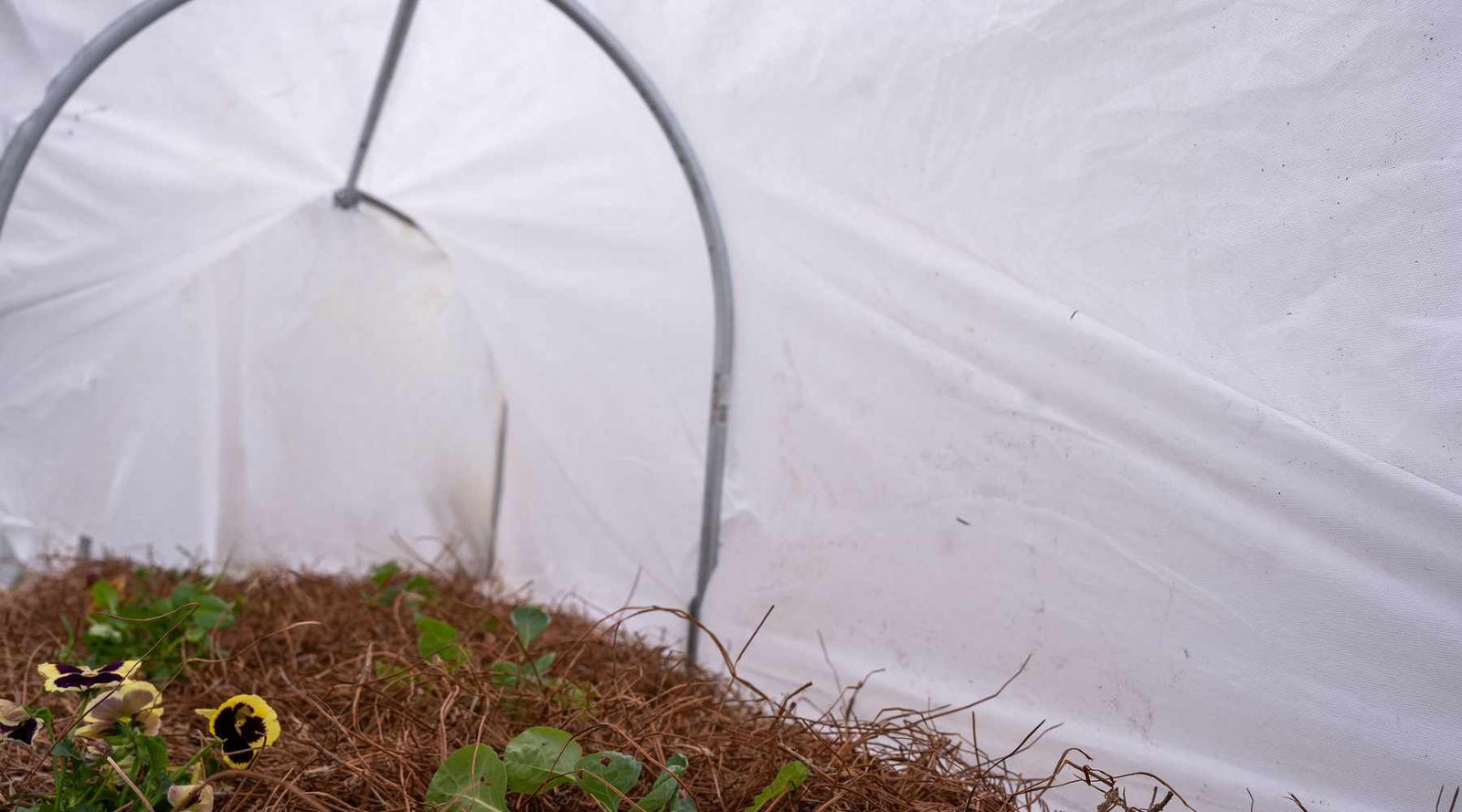Free Shipping on Orders over $75 to the Contiguous US
Free Shipping on Orders over $75 to the Contiguous US
Frost Blanket: How to Use It and When
October 08, 2025 4 min read 0 Comments

WHAT ARE FROST BLANKETS?
Frost blankets are garden covers made of lightweight, 100% polypropylene fabric. Frost blankets are ultra-lightweight, keeping your plants safe from damage. Unlike commonly used alternatives like bed sheets, burlap, or painter's tarps, the fabric allows plants proper airflow. They are also designed to dry quickly and will not become heavy from moisture. They are great to use in early spring to avoid damage from frost as well as during fall planting season to protect crops while they are establishing and not as hardy to the cooler temperatures.
WHEN TO USE A FROST BLANKET
Growers use frost blankets for several different types of applications. They offer opportunities for season extension with minimal infrastructure by:
- Covering late fall crops before frost.
- Protecting crops and newly transplanted seedlings from early spring frosts.
- Jump starting the growth of overwintered cool season annuals.
- Protecting newly planted seeds from being eaten by birds and increasing germination rates by keeping soil moist.
- Preventing newly sprouted seedlings in outdoor rows from being devoured by squirrels and other garden pests.
WHAT ARE THE DIFFERENT WEIGHTS OF FROST BLANKETS?
Bootstrap Farmer carries 0.9 oz, 1.5 oz., 2.5 oz., and 4.0 oz. frost blanket.
0.9 oz. - This ultra-lightweight fabric is ideal for season extension and insect protection rather than frost defense. It allows for maximum light transmission and airflow, making it a great choice for covering crops early in the season, shielding young seedlings from pests, or providing a few extra degrees of protection during mild nights.
1.5 oz.- This lightweight fabric option is perfect for longer-term applications or in areas where only a light frost will hit. Since it is so lightweight, sunlight can still easily penetrate.
2.5 oz.-This mid-weight fabric option offers a little more protection than the 2.1 oz. fabric but still allows for excellent light transmission.
4.0 oz.- This is a heavier duty fabric option for protection from frost. This material will not let as much light through, so we suggest this is used as a temporary application. A grower can use this fabric weight in conjunction with the 2.5 oz frost blanket for extra protection during a cold snap. This size is less than ideal for long-term application as it does not allow for as much airflow or sun penetration.
Bootstrap Farmer now carries 10' increments of frost blanket, so you always get the right fit!

How to Install Frost Blankets
Frost blankets can be installed on row crops with low-tunnel hoops or laid directly on the plants you wish to protect. The blanket can be anchored with landscape fabric pins, rocks, or sandbags. When used without hoops, frost blankets are commonly referred to as floating row covers. This is because their light weight allows them to essentially “float” above your plants, only resting on the tips of the leaves.
For more structured protection, pair frost blankets with a DIY Low Tunnel. Building a low tunnel creates a mini greenhouse effect, giving crops extra insulation, better airflow, and more stability in windy conditions. It’s an easy, affordable way to extend your growing season while keeping crops accessible for quick venting or harvesting.
You’ll want to install the frost blanket before the frost sets in. When the sun comes out and all danger of frost has passed, remove the covering and fold and store it correctly. It is vital that you remove the blanket when temperatures rise above 50 °F, as it can trap too much heat and stress plants. If soiled, lightly rinse the fabric with cool water and let it air dry completely before storing.
Related: How to Use Low Tunnels for Extending Your Growing Season
What Is The Best Material To Cover Plants From Frost?
The best material to use for covering plants is polypropylene fabric. It dries more quickly than other materials, is breathable for plants, and is lightweight enough not to cause any damage to delicate crops or plants. It is a favorite amongst growers because it allows light to pass through its fabric that plants need to thrive.

Can You Leave Frost Blankets On During The Day?
Frost blankets can be left on all day if lightweight, allow airflow, and allow light transmission. One trick many growers use is to layer fabrics. They will put down a lightweight frost blanket for daytime use and add a heavier duty frost blanket to ensure protection when the temperature dips after sunset. For cold hardy crops, you will want to be mindful of the advantages that come from cooler temperatures to the crop's flavor. These types of crops may benefit from exposure during the day and coverage after sunset.
Can Shade Cloth Be Used As Frost Cloth?
Shade cloth is not a great option for frost cloth. Often it is a woven netting, which would provide very little protection from wind and cold. Stick with frost blankets made of polypropylene fabric designed to create a barrier that retains heat from the soil around the plants.
Can You Use Plastic To Cover Plants From Frost?
Plastic formed into fabric sheets (polypropylene fabric) is an excellent material for frost protection. Look for frost blankets that resist moisture buildup and allow light to get to the plants easily for best results. You can also use greenhouse plastic to cover plants if you have hoops, but plastic film should not be laid directly on the plants as any water that collects will weigh down the plastic and damage your plants.
What’s the Best Frost Blanket to Use in Cold Climates?
A heavy-weight frost blanket like a 4.0 oz is best for extra cold climates. Lighter weighted frost blankets can be layered together for more versatility in cooler temperatures. The best frost blanket will be one that provides your plants with a barrier from the cold air that could damage the plant. It is important that the frost blanket is large enough to cover all the way to the ground. This helps retain the heat from the soil which will keep your plants on average 5-10 degrees warmer.
Do I Need to Remove the Frost Blanket in Snowy Weather?
Yes, frost blankets should be removed from your garden beds if you are expecting a heavy snow fall or at the very least shake the snow off of them if heavy accumulation occurs. Having row hoops will also help to prevent damage to plants. Excess snow will weigh the blanket down and cause it to fall on to your plants, squishing delicate seedlings and breaking stems on larger plants.
Subscribe
Sign up to get the latest on sales, new releases and more …
